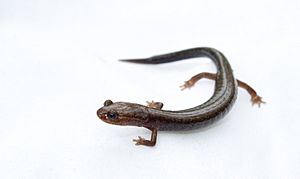Ravine salamander facts for kids
Quick facts for kids Ravine salamander |
|
|---|---|
 |
|
| Conservation status | |
| Scientific classification | |
| Genus: |
Plethodon
|
| Species: |
richmondi
|
The ravine salamander (Plethodon richmondi) is a type of salamander. It belongs to the Plethodontidae family. This means it breathes through its skin and mouth, not with lungs! This salamander lives only in the United States. Sadly, its home is sometimes destroyed, which is a problem for them.
Contents
Why It's Called the Ravine Salamander
The second part of its scientific name, richmondi, honors the person who first found it. His name was Neil D. Richmond. He later became a curator at the Carnegie Museum of Natural History in Pittsburgh, Pennsylvania.
Where Ravine Salamanders Live
The ravine salamander can be found in several states in the eastern United States. These include eastern Kentucky, Ohio, and southern West Virginia. They also live in western Virginia, northwestern North Carolina, northeastern Tennessee, and southwestern Pennsylvania.
What Ravine Salamanders Look Like
An adult ravine salamander is usually about 7.5 to 11.5 centimeters (3 to 4½ inches) long. They have short legs and look a bit like a worm. They also move like a worm!
Their back and sides are dark brown or black. They have tiny silver or brass-colored spots. Unlike some other small salamanders, their belly is also dark brown or black.
Ravine Salamander Habitat and Life Cycle
Ravine salamanders like to live in temperate forests. They especially prefer the slopes of valleys and ravines. They live on land, often found among fallen leaves. They hide under logs, stones, or tree stumps.
These salamanders hibernate underground during the winter. They also aestivate (rest) underground when summer is very hot. Female salamanders lay their eggs in small cracks and hidden places. The eggs hatch directly into tiny salamanders. There is no larval stage that lives in water, like with some other amphibians.
Conservation Status: Are They Safe?
The biggest problem for the ravine salamander is that its habitat is being damaged. Some groups of these salamanders have been lost because of this.
However, the ravine salamander is still common in many places where it lives. It can be found in several protected areas. Overall, the number of ravine salamanders seems to be staying steady. Because of this, the International Union for the Conservation of Nature says it is of "least concern". This means they are not currently in danger of disappearing.


